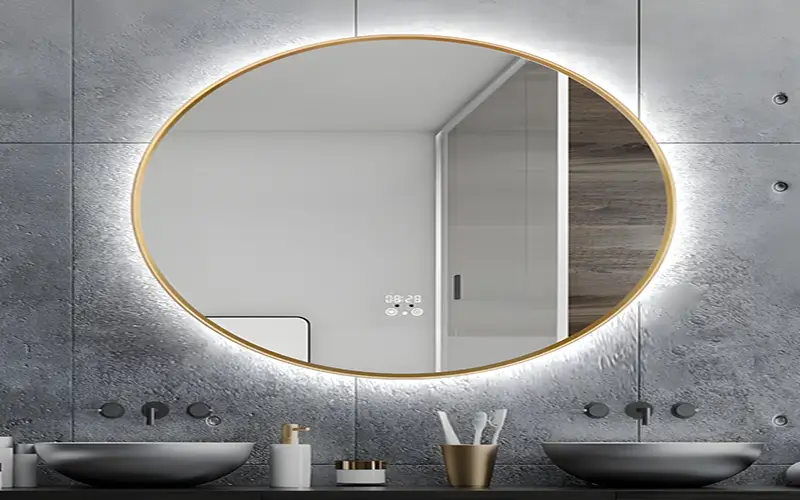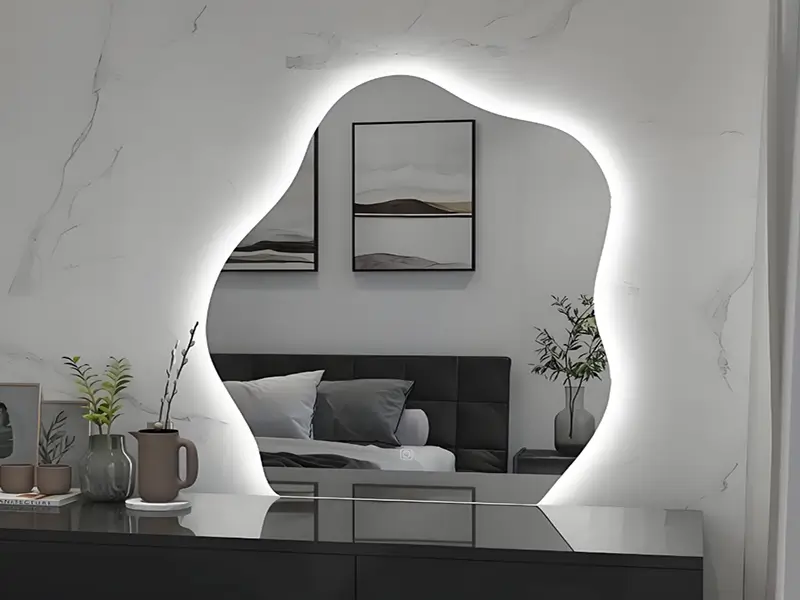
With the development of LED lighting, we have found that many things in life can be associated with it. Mirrors are indispensable in everyone’s home. They can open up space, add depth to the room, and show yourself. Using beautiful backlight mirror to design spaces is one of the fastest-growing interior design trends. Whether you want to create a high-end bathroom mirror, a practical makeup mirror, or an atmospheric dressing mirror, you can achieve elegant, soft, and powerful light effects by properly installing LED strip lighting.
Different shapes and positions of mirrors require different installation methods. This article will start with the principle of the LED strip to backlight mirrors. It will gradually take you through planning, material selection, preparation, and installation, so that you can truly “do it yourself and beautify the space.”
How to Create Light With a Mirror?
This is a good question, because the mirror itself does not emit light. But it can reflect light and enhance visual brightness.
We consider that the LED strip can be installed behind the mirror, and the light is reflected along the wall or surface to form a “backlight” effect, which not only softens the visual effect but also avoids the shadow or glare caused by the front light source. At the same time, it will also enhance the overall light sense and level of the room.
What is the Role of Backlit Mirrors with LED Strip Lights?
In modern homes, mirrors generally do not have light. At night, the mirror looks a bit dull and uncomfortable. Therefore, the design of backlit mirrors is not limited to decoration, it can also improve people’s psychological comfort.
Makeup/dressing mirror lighting
Provide uniform light from the side or back, to avoid shadows on our faces and make makeup more accurate.

Bathroom lighting
Provide an auxiliary light source when washing at night, which is not dazzling and safe at night. And now it can be controlled intelligently, and you can turn it off or on with your body when you need it.
Dressing/full-length mirror
The full-length mirror has a backlight, which can clearly restore the color of clothes and facilitate matching clothes.

Planning Before Backlighting a Mirror with LED Strips
Before you start a project, you need to understand the type of mirror, the purpose of the installation, where the mirror will be installed, etc. Let’s analyze each one.
Purpose of Lighting:
First, you need to figure out the purpose of lighting your mirror with LED strips. Why do you want to install lighting in this area and behind the mirror?
Do you want to add more light to this area, for task lighting, or another specific purpose? Do you want to create a vibrant space with bright colors and effects? Think about your intentions and what you want the lighting to achieve. Mirror lighting can achieve different purposes at the same time.
Types of Mirrors:
Mirrors come in a wide variety of types, from plain round mirrors to large wooden framed mirrors. They come in different shapes, sizes, and functions.
If you want to backlight your mirror, you will need to find floating mirrors and mirrors that are part of a vanity or dressing table. Backlit mirrors require enough space behind the mirror, so make sure there is enough space behind the mirror for the light to illuminate the wall.
Mirror Installation Location
When installing a mirror, location is crucial. Where will the mirror go? In the bathroom, bedroom, living room, dressing room, entryway, dining room, or closet? These are all questions that you need to consider. Understanding the purpose of the mirror helps determine the desired lighting and atmosphere.
Conditions for mirror installation
When installing a mirror, there are several factors to consider. Ask yourself the following questions: Does the mirror have a base? Is it fixed to a cabinet or dressing table? Is there enough space behind the mirror to place a lamp? And so on. This will help you better plan and install the mirror. At the same time, ensure safety and functionality.
How Do I Choose the Right LED Strip for Mirror Backlighting?
Once you know the purpose and location of the space you want to light, you can choose the type of LED lighting. Our LED light strips offer a variety of output options, brightness levels, and types.
Single-color LED strips
Static white LED strips emit a constant, unchanging single color of light. For example, 2700 K- 6500 K, static white light is ideal when a constant color temperature is required.
Dual-color white LED strips
LED tape tunable white lighting is adjustable in two color temperatures, such as 2700K+6500K. You can choose between warm white and cool white tones of white light that best suit your needs. You can control these lights using dimmer switches, remote controls, and even smartphone apps.
RGB color-changing LED strips
RGB color-changing LED strips allow you to control any color you want. The RGB refers to red, green, and blue because LED lights contain three chips, each of which emits one of these colors. You can choose based on your needs.
Brightness
LED strips should provide enough brightness to create the atmosphere you want or accomplish the tasks you want to accomplish. But consider the size of the room, the height of the ceiling, and the type of light you want. Brightness is measured in lumens.
When comparing LED strips, make sure you know how many lumens they emit per foot.
- 80-120 lumens per foot for low accent lighting.
- 180-300 lumens per foot for brighter accent lighting and low ambient lighting.
- 350-500 lumens per foot for ambient or task lighting.
- 700+ lumens per foot for a large commercial bathroom with a high ceiling.
Color Temperature
If using static white light or adjustable dynamic white light, please choose the appropriate room color temperature according to the desired atmosphere. Generally, monochrome color temperature is more common, 2700K/3000K4000K.
Color Rendering Index (CRI)
Color temperature and color rendering index are related. The color rendering index (CRI) measures the accuracy of the color reproduction of objects compared to natural light. It rates the quality of light on a scale of 0 to 100. In applications where color accuracy is critical, a high color rendering index (CRI) is essential.
We strongly recommend that when choosing LED strips, the CRI should be at least higher than 90 or higher. A high color rendering index will make the colors bright and light, and we can easily distinguish them clearly.
How to Install the LED Strip lights on the Mirror?
For us to install the LED strip lights smoothly, we need to prepare the following materials. And refer to these steps. For more details, pls read How to Install LED Strip Lights Around a Mirror?
Pre-installation preparation list
Materials and tools:
- LED strip (select type and length)
- Power adapter (DC12V or 24V)
- Controller (if dimming is required)
- Adhesive/3M glue/hot melt glue/bracket slot
- Scissors, tape measure, and electrical tape
- Connector/welding tool (if cutting)
Position measurement:
- 2~4cm from the wall is the best to avoid the light being too “dead” or the shadow being obvious.
- The power supply should be close to the mirror, and where there is a socket, or hidden with an extension cord.
How to Install LED Strips on the Back of a Mirror?
Once you have prepared the tools and materials mentioned above, we can start installing the product.
Determine the length of the LED strip
First, measure the length of the mirror and cut the LED strip accordingly. Cut the strip at the designated cutting points. This ensures that the strip fits the mirror perfectly and avoids unnecessary damage or irregularities.
Draw a schematic diagram for the LED strip installation. Where you cut the corners, we recommend using solderless connectors or soldering the LED strip to the wires between the sections.
Mount the LED strip to the mirror
We recommend mounting the strip 3 to 4 inches from the edge of the mirror. Remove the adhesive backing from the LED strip and stick it to the back of the mirror. Be sure to press firmly to ensure a secure fit. For round mirrors, use flexible strips to create a more natural arc shape
Connect the LED strip to the power supply and control system
Connect the connectors to both ends of the LED strip, and then connect it to the power supply. Make sure the power supply is plugged into an electrical outlet. Also, make sure the voltage of the LED strip is the same as the power supply.
Test the LED Strip Again
Turn on the power supply and test the LED strip to make sure it is working properly. If the light does not come on or is a little stuck, check the connection and try again.
Hide the wiring
Use wiring ducts, back clips, or wall wiring to hide the accessory. For the power supply, we recommend placing it inside or behind the mirror cabinet.
Clean the mirror and enjoy the backlight
Make sure the mirror is clean and free of any stains or dust. This will ensure that the LED strip is visible and enhance the appearance of the mirror.
Summary
LED strip lights mirror backlight not only enhances the space level, but also makes daily life more textured. We need to choose the LED light strip in advance, plan the line, and strictly follow the steps. Even if you have no electrical experience, you can easily create a high-value and practical LED mirror backlight effect.
We are committed to providing customers with high-quality LED lighting solutions that are not only fully functional, but also beautiful and beautiful. We provide a wide variety of LED tape to help you choose the perfect lighting solution for your space.
FAQs
To backlight a mirror, the first thing we would consider is to install LED strips so that the light bounces off the wall. Simply secure the strips with double-sided tape or mounting slots and connect them to a power source.
I would recommend high-density LED strips (e.g., 240 LEDs per meter or more), with a high color rendering index (CRI) (90+) and a neutral white light color temperature (4000 K- 5000 K). If you are only using it for functional lighting, such as makeup, you should stick to single-color, high-CRI strips.
Of course, our LED strips are all cuttable. You need to look at where the cuts are on the LED strip PCB board. Be sure to cut along these markings to avoid damaging the circuit.
Yes, but for bathroom lighting, you need to consider the waterproof level. But make sure to use LED light strips and moisture-proof power supplies with a waterproof level of IP65 or higher. All connections should be sealed to prevent damage from moisture.
Yes, but your LED strip must support dimming. And connected to a compatible dimmer switch, remote control or smart controller, you can easily adjust the brightness to meet your needs.
